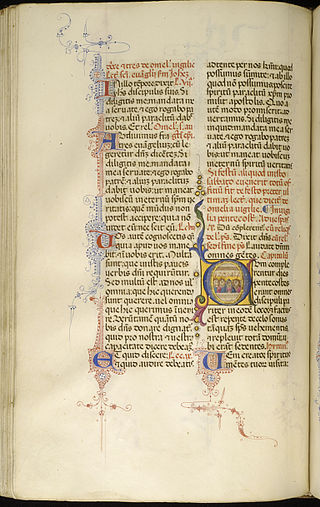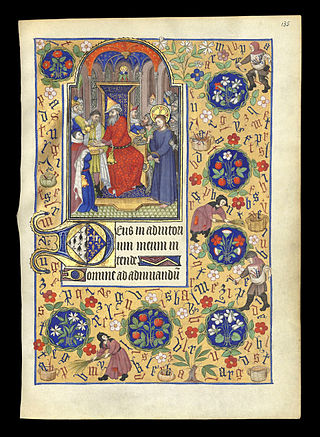
Te lucis ante terminum ('To Thee before the close of day') is an old Latin hymn in long metre. It is the hymn at Compline in the Roman Breviary .

Te lucis ante terminum ('To Thee before the close of day') is an old Latin hymn in long metre. It is the hymn at Compline in the Roman Breviary .
S.-G. Pimont argued for the authorship of Ambrose of Milan. [1] The Benedictine editors and Luigi Biraghi disagreed. [2]
The hymn is found in a hymnary in Irish script (described by Clemens Blume in his Cursus, etc.) of the eighth or early ninth century; but the classical prosody of its two stanzas (solita in the third line of the original text is the only exception) suggests a much earlier origin. In this hymnary it is assigned, together with the hymn Christe qui splendor et dies (also known as Christe qui lux es et dies), to Compline. [2]
An earlier arrangement (as shown by the Rule of Caesarius of Arles, c. 502) coupled with the Christe qui lux the hymn Christe precamur adnue , and assigned both to the "twelfth hour" of the day for alternate recitation throughout the year. The later introduction of the Te lucis suggests a later origin. [2]
The two hymns Te lucis and Christe qui lux did not maintain everywhere the same relative position; the latter was used in winter, the former in summer and on festivals; while many cathedrals and monasteries replaced the Te lucis by the Christe qui lux from the first Sunday of Lent to Passion Sunday or Holy Thursday, a custom followed by the Dominicans. The old Breviary of the Carthusians used the Christe qui lux throughout the year. The Roman Breviary assigns the Te lucis daily throughout the year, except from Holy Thursday to the Friday after Easter, inclusively. Merati, in his notes on Galvanus' Thesaurus, says that it has always held without variation this place in the Roman Church. As it is sung daily, the Vatican Antiphonary gives it many plainsong settings for the varieties of season and rite. [2]
| Latin text (original) [3] | Free English translation by J. M. Neale [4] |
|---|---|
Te lucis ante terminum, | Before the ending of the day, |
The 1632 Urban VIII version makes classicizing revisions.
| Latin text (Urban VIII) [5] |
|---|
Te lucis ante terminum, |
The 1974 revision replaces the second strophe with the following two strophes from the hymn Christe precamur adnue. [a]
| Latin text [6] | English verse translation [7] |
|---|---|
Te corda nostra sómnient, Vitam salúbrem tríbue | Lord, when we sleep, be in our hearts, Your living power breathe from above, |

The Roman Breviary is a breviary of the Roman Rite in the Catholic Church. A liturgical book, it contains public or canonical prayers, hymns, the Psalms, readings, and notations for everyday use, especially by bishops, priests, and deacons in the Divine Office.

In the practice of Christianity, canonical hours mark the divisions of the day in terms of fixed times of prayer at regular intervals. A book of hours, chiefly a breviary, normally contains a version of, or selection from, such prayers.

"Gloria in excelsis Deo" is a Christian hymn known also as the Greater Doxology and the Angelic Hymn/Hymn of the Angels. The name is often abbreviated to Gloria in Excelsis or simply Gloria.
Vexilla regis prodeunt is a Latin hymn in long metre by the Christian poet and saint Venantius Fortunatus, Bishop of Poitiers. It takes its title from its incipit.

The Liturgy of the Hours, Divine Office, or Opus Dei are a set of Catholic prayers comprising the canonical hours, often also referred to as the breviary, of the Latin Church. The Liturgy of the Hours forms the official set of prayers "marking the hours of each day and sanctifying the day with prayer." The term "Liturgy of the Hours" has been retroactively applied to the practices of saying the canonical hours in both the Christian East and West–particularly within the Latin liturgical rites–prior to the Second Vatican Council, and is the official term for the canonical hours promulgated for usage by the Latin Church in 1971. Before 1971, the official form for the Latin Church was the Breviarium Romanum, first published in 1568 with major editions through 1962.
"Quem terra, pontus, sidera", also known by its more ancient name, "Quem terra, pontus, aethera", is a latin-language Christian hymn in long metre, in honour of the virgin Mary, mother of Jesus, attributed to Venantius Fortunatus.
Robert White probably born in Holborn, a district of London, was an English composer whose liturgical music to Latin texts is considered particularly fine. His surviving works include a setting of verses from Lamentations, and instrumental music for viols.
Rerum Deus Tenax Vigor is the daily hymn for None in the Roman Catholic Breviary.
The Ambrosian hymns are a collection of early hymns of the Latin liturgical rites, whose core of four hymns were by Ambrose of Milan in the 4th century.
"Adoro te devote" is a prayer written by Thomas Aquinas. Unlike hymns which were composed and set to music for the Solemnity of Corpus Christi, instituted in 1264 by Pope Urban IV for the entire Latin Church of the Catholic Church, it was not written for a liturgical function and appears in no liturgical texts of the period; some scholars believe that it was written by the friar for private use at Mass. The text has since been incorporated into public worship as a hymn.
Sacra jam splendent is a Roman Catholic hymn for Matins on the Feast of the Holy Family.

"Deus, in adiutorium meum intende", with the response "Domine, ad adiuvandum me festina" are the first verse of Psalm 70 : "Make haste, O GOD, to deliver me; make haste to help me, O LORD." In this form they are a traditional Latin Christian prayer.
In Roman Catholic liturgy, Rex Gloriose Martyrum is the hymn at Lauds in the Common of Martyrs given in the Roman Breviary. It comprises three strophes of four verses in Classical iambic dimeter, the verses rhyming in couplets, together with a fourth concluding strophe in unrhymed verses varying for the season.
Aurora lucis rutilat is the incipit of an Easter hymn of the Latin rite, first recorded in the Frankish Hymnal tradition and preserved in the Benedictine "New Hymnal" . In the numbering introduced by Gneuss (1968), it is no. 41 of the Old Hymnal, and no. 72 of the New Hymnal. The hymn has 12 strophes of 4 verses each as originally recorded;in modern translations it is often reduced to 11 or fewer strophes. The Old High German interlinear version in Bodleian Junius 25 begins Tagarod leohtes lohazit.

"Te Splendor" is a Roman Catholic hymn dedicated to Saint Michael, the Archangel. The hymn derives its name from the fact that in Latin it begins with the words: Te splendor et virtus Patris. The hymn is found in the Roman Breviary.
Evening Hymn, "Te lucis ante terminum", is an anthem composed by Henry Balfour Gardiner, a setting of the Latin compline hymn "Te lucis ante terminum" for four voices and organ, in both English and Latin. It was published in 1908. It is regarded as Gardiner's best-known work and a classic of the English choral tradition.

Conditor alme siderum is a seventh-century Latin hymn used during the Christian liturgical season of Advent. It is also known in English as Creator of the Stars of Night, from a translation by J.M. Neale.

Friedrich Dörr was a German Catholic priest and professor of theology, who is known as a hymnwriter. He shaped the first common German Catholic hymnal, Gotteslob, published in 1975.
Audi benigne Conditor is a Latin hymn used during Lent attributed to Gregory the Great, who reigned as pope from the year 590 until the year 604.
![]() This article incorporates text from a publication now in the public domain : Herbermann, Charles, ed. (1913). "Te Lucis Ante Terminum". Catholic Encyclopedia . New York: Robert Appleton Company.
This article incorporates text from a publication now in the public domain : Herbermann, Charles, ed. (1913). "Te Lucis Ante Terminum". Catholic Encyclopedia . New York: Robert Appleton Company.